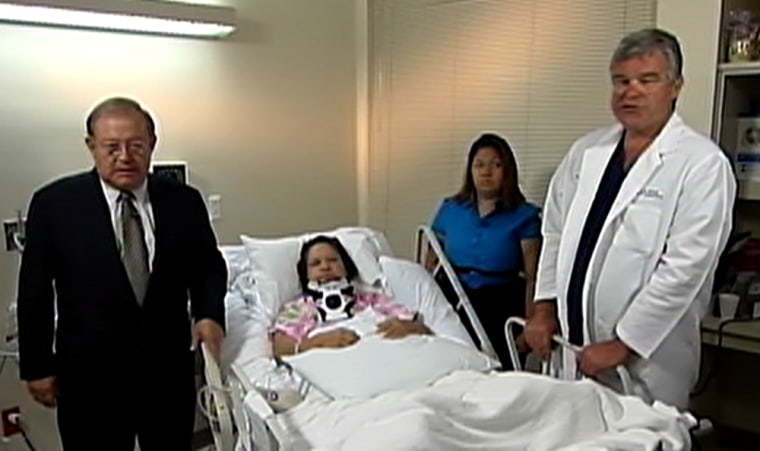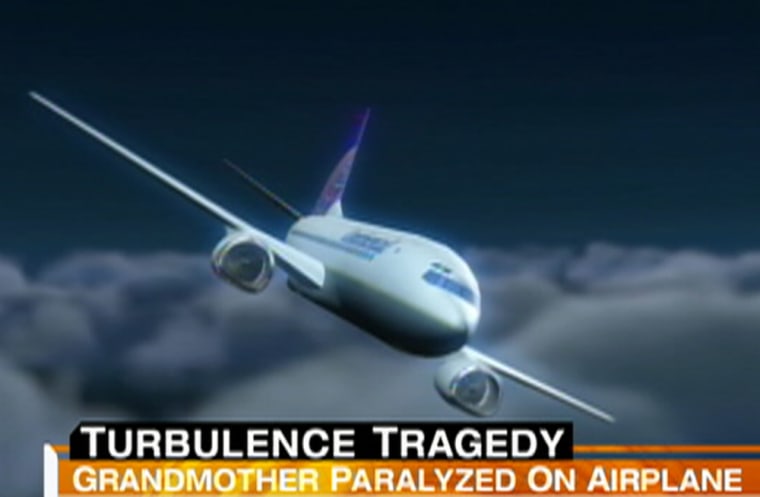The airline says the seat-belt sign was lighted. But the passenger says she didn’t hear anyone say she had to keep her belt fastened. In any event, others were using the bathroom, so she didn’t see any harm in a quick trip.
Sylvia Tena repeated that account for TODAY’s Matt Lauer Tuesday from a hospital bed in her hometown of McAllen, Texas. With a brace stabilizing her fractured neck, she said that only now, more than six weeks after a pocket of turbulence threw her against the ceiling of the airplane’s bathroom, is she regaining a tiny bit of movement in her lower body.
“I noticed that I started moving my toes, so I think that’s a good sign,” the 47-year-old grandmother and mother of three told Lauer.
Whether she ever walks or regains full mobility remains to be seen, her surgeon, Dr. Trey Fulp, told Lauer. “There’s certainly encouraging signs. When she first came in, she had no motor control or sensory from the neck down,” Fulp said from Tena’s bedside. “Time will tell.”
Conflicting accounts?Tena’s life changed, perhaps forever, early on the morning of April 18 aboard Continental’s flight 511 from Houston bound for her home in McAllen, a town on the Rio Grande just west of Brownsville. The late flight had been scheduled to depart on the night of April 17, but the departure was delayed at least three hours.
There are differences in the official account of the flight filed with the National Transportation Safety Board by Continental and Tena’s account, as told to TODAY by Tena’s lawyer, Ramon Garcia. Continental’s posted schedule lists the plane’s normal departure time as 9:25 p.m. for the 75-minute flight. Everyone agrees the plane didn’t leave until after midnight, but Garcia told Lauer that the flight was delayed six hours.
Garcia also maintained that the passengers spent two hours inside the plane on the ground before takeoff, and that the flight attendants served them water during the wait. The airline says the plane was delayed three hours and the passengers were in the plane on the ground just 30 minutes before it took off.

What isn’t debated is that there was a line of thunderstorms between Houston and McAllen. Continental’s report to the NTSB says that because of the bad weather, the flight crew told passengers repeatedly during the flight to keep their seat belts fastened. Beverage service was canceled and the flight attendants were also told to stay belted in their seats, the airline told investigators. Seat-belt signs remained lit during the entire flight.
Tena was sitting in the last row next to the rest room. Her family told NBC News that she suffers from diabetes and needs to use the rest room more frequently as a result. Tena said she saw several others using the rest rooms and thought there would be no harm in making a quick trip herself.
But once she was there, the plane, which by now was making its approach to McAllen, hit a pocket of severe turbulence. “I did the bathroom and everything. I was going to wash my hands and I was about to open the door when I flew up,” Tena said.
First aid on board
Lauer asked Tena if she heard any announcements telling passengers to remain seated and belted in. She said she didn’t. “There was four other persons who don’t know English, and I was translating for them, and I would remember,” she said.

The turbulence lasted just 15 seconds, but the 737 jet rolled about 30 degrees and hit severe updrafts and downdrafts during that time.
After passing through the turbulence, a flight attendant notified the captain that there were three injuries in the aft cabin. One passenger and one flight attendant were not seriously injured, but Tena, on the floor of the bathroom, was unable to move.
The flight crew notified ground controllers that there was a medical emergency on board and the plane needed to land as quickly as possible. Meanwhile, a physician, Dr. Andrew Levine, was on the flight and gave first aid to Tena, stabilizing her after her injury. Once on the ground, she was taken to a hospital in McAllen, where she was put on a ventilator to help her breathe.
Fulp told Lauer that Tena suffered two spinal cord injuries, one in her neck and one in her upper back. The one in her neck, a fracture of the second cervical vertebra, was the one that left her paralyzed.
The injury is known to physicians as a “hangman’s fracture,” Fulp said. “It was the same fracture one gets with a judicial execution.” It was potentially life-threatening, he said, adding, “She’s very fortunate Dr. Levine was on the plane with her.”
Tena underwent six hours of surgery after the accident and is no longer on a ventilator. There was no report on how long she may remain in the hospital.
Continental Airlines has declined to comment on Tena’s injury, saying that it has made its report to the NTSB and wants to wait until the official investigation is complete. But Garcia, Tena’s attorney, claims that the injury is not Tena’s fault.
“This lady did nothing wrong,” he said. “There was no turbulence when she got up to go to the bathroom.”